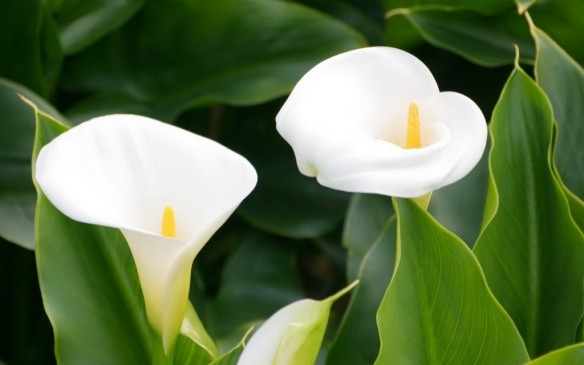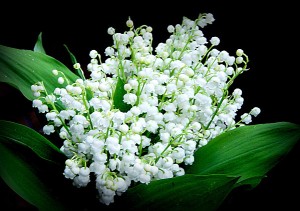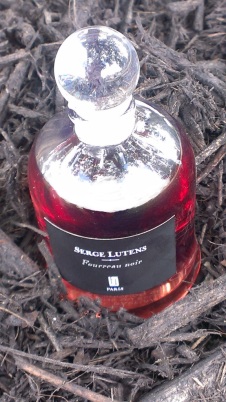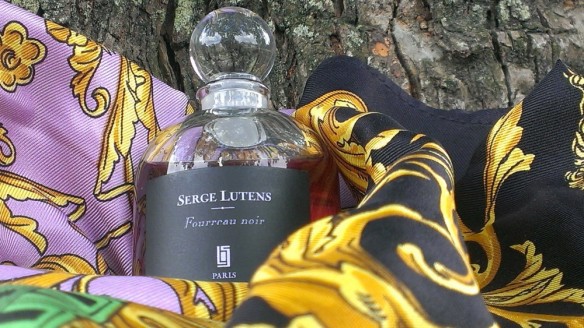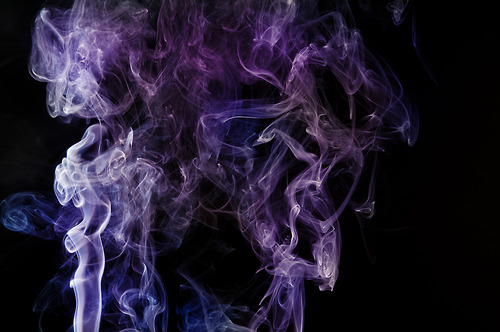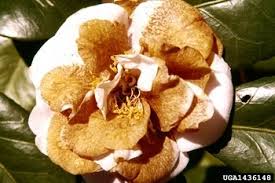It’s hard to live up to a powerful name. Even harder when that name is something that seems to reference both Joan of Arc, and perhaps the most notorious of all medieval torture devices, the Iron Maiden. So, I put all titular and symbolic considerations aside when I tested the latest fragrance from Serge Lutens, La Vierge de Fer, and looked at it in a vacuum. With deep regret and sadness, I have to say that I think it is the worst perfume that I’ve ever tried from Serge Lutens, and more suited to a cheap department store.
La Vierge de Fer is a floral eau de parfum whose name translates to “The Iron Maiden” (or virgin). It was created by Christopher Sheldrake, and released in September of this year as one of the famous, pricey, bell jar “Paris Exclusives.” The perfume is not sold world-wide, but is limited to Serge Lutens’ Paris headquarters, the Lutens websites, or to the Lutens section of Barney’s New York.
The inspiration for the fragrance seems to vary depending on which source you read. Some say that La Vierge de Fer was inspired by Picasso’s Les Demoiselles d’Avignon, others talk about Joan of Arc, or the medieval torture device called the Iron Maiden. A few mention Serge Lutens’ mother and how the fragrance is partially an homage to her. (You can read about Serge Lutens’ childhood, and how his mother was forced to abandon him as a baby in the first part of my profile on Monsieur Lutens.)
In an interview with Ozmoz, Monsieur Lutens seemed to give a nod to a few of these things:
The name you picked, La vierge de fer (The Iron Maiden), is pretty intense. There’s a reference to torture. Is there perhaps a connection to Joan of Arc, too?
SL: All maidens have a connection between them. Joan of Arc kicking the English out of France is one of the loves of my life. Whether she’s wearing armor or crowning the King of France, she’s a reference, absolutely, but not here. The Iron Maiden is more of an attitude. My own attitude towards what creates beauty. You can’t conceive of anything without a certain fragility, a scar at the bottom of it all. Opening that scar to make it universal is the basic principle of Art. An iron maiden used to be an instrument of torture. And if the term ‘to create’ means anything, it means that whoever does it is tortured and sacrificed on the alter of something.
On his website, Serge Lutens doesn’t add any clarification, writing and describing the perfume rather cryptically:
The religion of iron needed a Virgin, and the Virgin, a lily.
“Have you smelt it?”
“Yes, I have.”
“And how is it?”
“As striking as the fleur-de-lis seal on the arm of a criminal.”
“Never?!”
“And deep down, as itchy as a hair shirt on the skin. In fact, a sublime torture!”.
As always, Serge Lutens keeps the perfume’s notes secret. Surrender to Chance says they are:
Lily, jasmine, amber, vanilla and sandalwood.
The notes I detect are slightly different:
Lily, aldehydes, muguet (or lily of the valley), jasmine, generic amber, white musk, vanilla.
La Vierge de Fer opens on my skin with notes that are, indeed, as itchy as a hair shirt, though the torture is far from “sublime,” in my opinion. There is a heavy layer of soapy aldehydes that have a lemony undertone. They are followed by lilies that don’t smell like indolic Stargarzers so much as the fresher Calla lily shown in the photo. I also detect a subtle, green whiff of dainty, dewy lily-of-the-valley which I’ll just call by its French name, muguet, in order to avoid any confusion. The whole thing smells as fresh as Dior’s legendary Diorissimo, which would be fine and dandy were it not for the white synthetics.
The green-white floral bouquet is infused with a sharp white musk that sends a piercing pain through my eye every time I smell La Vierge de Fer up close. It starts off resembling expensive hair spray, which is bad enough without its fast transition into the most potent of laundryesque dryer sheets. It is astoundingly bad, astoundingly cheap, and just plain astounding — period — from a house like Serge Lutens. One reason why I like his perfumes is because they generally (with some exceptions) eschew very heavy amounts of synthetics, and, even then, it’s rarely the cheapest form around: common white musk. I don’t go to Serge Lutens for a fragrance that smells like any white florals found in Sephora or Macy’s. I don’t pay his prices for what a celebrity might put out for $30, and I most certainly do not expect such a scent in one of the uber-expensive bell jars whose price has just gone up in the U.S. to $310. The depths of my disappointment and disbelief knows no bounds.
As I struggle to stop wincing at the shooting pains in my head from the Bounce fabric softener sheets, I notice the odd contrasts emerging in La Vierge de Fer. The fragrance runs hot and cold, metallic and gourmand, in a mix that is both discordant and perplexing. The top notes are soapy aldehydes, piercing white musk, and fresh, green-white lilies, but there is a metallic clang surrounding them that goes beyond mere coldness. It’s as though there were a vein of chilled silver running through the notes, no doubt due to the bloody white musk and the aldehydes. The latter quickly lose their lemony overtones, and turn into pure soap with a tinge of waxiness.
Appearing underneath the cool, white bouquet are sudden flashes of something warm, dusty, and sweet. At times, it feels like richly custardy, sweet vanilla. Other times, it’s like dusty, dark, vanilla extrait in unrefined, unprocessed powder. The rich sweetness in the base acts like a wave hitting the green-white floral shores before pulling back, then returning once more. It’s almost like a sort of relay race between the sweet gourmand notes and the alternating cool, metallic, clangy element, the soapy aldehydes, and that piercingly sharp, laundryesque, white musk. It’s rather brilliant on an intellectual, theoretical level, but somewhat disorienting and perplexing on a purely olfactory one.
I’m not happy. I have not been happy on any of the occasions when I’ve tested La Vierge de Fer. Lily is perhaps my favorite floral note, and white floral bombs are the one kind of floral scent that I gravitate towards, but I can’t decide which part of La Vierge de Fer I find more off-putting. So, it’s probably a small mercy then that the perfume has such incredibly weak projection. Within minutes, it feels as though it were evaporating off my skin. Well, everything except that revolting white musk. In less than 10 minutes, in fact, La Vierge de Fer is a complete skin scent on me, which is pretty astonishing. I have problems with longevity, not sillage, but 10 minutes? For an eau de parfum?!
La Vierge de Fer also suffers from the cardinal sin of being utterly boring. I have nothing against soliflores — perfumes celebrating and revolving around one main note — if they are interesting or well-done. For me, however, La Vierge de Fer is tedious and banal. Exactly 20 minutes into its development, the perfume loses that odd metallic clang and coldness, and the relay race with the vanilla ends. I wasn’t keen on it, but at least it was interesting, and I could see how the metal might be a symbolic representation of either Joan of Arc’s armour, or the steel spokes of the Iron Maiden as it pierced flesh warm from vanilla and white from lilies. Once that extremely clever bit of elegiac sophistication vanishes, you are left with nothing more than lilies infused with soapy aldehydes and horrific commercial musk. Even the more green muguet note vanishes, if it was even there at all. It’s hard to tell under all the synthetics, especially given how wispy the fragrance is on my skin.
It takes about 75-minutes for La Vierge de Fer to change, though it’s minor at best. At first, there is a subtle, nebulous change in the perfume’s temperature and feel, as though there were a growing warmth in the base. It’s not vanilla, and it’s most definitely nothing that is actually ambered, but La Vierge de Fer seems less crisp and fresh. The jasmine starts to come out, slowly vying with the lily for dominance, and turning the fragrance sweeter. Eventually, by the end of the 2nd hour, La Vierge de Fer begins to shed some of its laundryesque sharpness like an unpleasant snake’s skin, though the jasmine can’t erase all of it. The perfume is now jasmine and lily on an abstract, sweet, warm base that is infused with Bounce dryer sheets. By the end of the 3rd hour, La Vierge de Fer is nothing more than a blur of whiteness (and synthetics) that feels as though it’s about to die entirely.
To my surprise, La Vierge de Fer hangs on tenaciously, chugging away in the most translucent smear on my skin. It still gives me an immediate pain in my head every time I smell it up close, but the perfume is definitely there if you put your nose right on your arm and inhale forcefully. What is surprising is an odd, unexpected fruitiness that suddenly pops up alongside the clean, white musk in the base. To the extent that I can make out anything from La Vierge de Fer’s thinness, it almost smells like dark grapes. It has to be the indoles so prevalent in white flowers like jasmine; indoles can be broken down to something called methyl anthranilate, a natural compound which has a fruity aroma, often like that of Concord grapes (among other things). Whatever the reason for the sudden fruitiness, it is a fleeting thing that shows up on in the tiniest of ways and towards the end on my skin around the middle of the 5th hour.
The perfume dies shortly thereafter, giving its last gasp just a little over 7 hours from the time I first applied it. In its final moments, it was nothing more than cheap, synthetic white “cleanness.” The 7 hours comes from an average quantity of about 3 smears, or about 2 sprays. At a smaller dosage amounting to one good-sized spray, La Vierge de Fer lasted only 5.75 hours on my skin. Were it not for piercing musk, which my skin clings onto like glue, I suspect the whole thing would have died after three hours, no matter how much I applied.
If I were to be diplomatic about the reactions to La Vierge de Fer that I’ve observed in groups or on various sites, I would say that they are mixed. Some eventually grow to appreciate the perfume as was the case for Bois de Jasmin, who wrote, in part:
La Vierge de Fer is neither punk nor bizarre. It’s not particularly dark either. I would put it as one of the more approachable and easy to like florals from Lutens’s impressive collection. It’s quite demure and delicate next to the bombshells like Tubéreuse Criminelle or Fleurs d’Oranger. The tender sweetness of jasmine is contrasted with the champagne of aldehydes in the top notes, and this beautiful contrast between softness and sparkle is carried on into the drydown. […][¶]
Jasmine and lily fireworks notwithstanding, La Vierge de Fer was not love at first inhale for me. I found it too simple and not challenging enough. But as I continued to dip into my sample, I found it more and more compelling. It’s simultaneously comforting and sophisticated, which makes it versatile enough to wear for just about any occasion. You simply have to love being showered with white flowers.
Well, I do happen to “love being showered with white flowers,” but I personally wouldn’t wear La Vierge de Fer if it were given to me for free. And no amount of time or testing is going to change my feelings.
In my opinion, La Vierge de Fer could go right next to the sort of clean, fresh, white, Spring-like floral scents found in Dillard’s, TJ Maxx, or Sephora. There’s nothing wrong with that if that is your taste, but I doubt anyone would want to pay $310 for it. One spends that sort of money on a Serge Lutens bell jar to get a wholly unusual, creative, innovative scent with a twist — a scent that has a complex, morphing character that is different from everything else out there, and that doesn’t come with a massive wallop of cheap synthetics. I realise that Serge Lutens has veered as of late towards lighter, thinner, simpler fragrances, and away from the complex (often Oriental) perfumes with which he began his line in the early 1990s, but I think La Vierge de Fer suffers from more than mere simplicity. I find it tedious and absolutely terrible. In almost every case with Serge Lutens — even when a particular fragrance doesn’t suit my personal tastes — I can admire the artistry, think it is well-done, and respect it. That is not the case here. I don’t think La Vierge de Fer even deserves to carry the Serge Lutens name.




